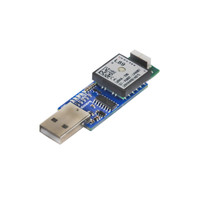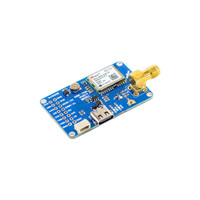The L89HA Breakout Multi-GNSS IRNSS-enabled by 7Semi is an advanced navigation solution that seamlessly integrates Quectel’s GNSS module with dual embedded antennas, allowing simultaneous operation on L1 and L5 bands. This board is powered by a 3.3V supply and establishes communication with the target MCU through an I2C / UART interface. Additionally, it includes a BAT connection pin for backup power supply. The breakout, equipped to acquire and track signals from GPS, IRNSS, GLONASS, BeiDou, Galileo, and QZSS, significantly reduces time-to-first-fix, ensuring precise navigation.
The L89HA Breakout stands out as a top-tier multi-GNSS engine supporting GPS, IRNSS, GLONASS, BeiDou, Galileo, and QZSS satellite systems. Engineered for accuracy and reliability, this compact GNSS module caters to diverse applications such as navigation, tracking, timing, and geofencing.
A notable feature of the L89HA Breakout is its 3.3V power supply, simplifying integration into various systems and devices. Offering both I2C and UART interfaces, it ensures adaptability with a broad spectrum of microcontrollers and processors.
Enhancing design simplicity and reducing system size, the breakout incorporates embedded patch and chip antennas. This feature makes it particularly suitable for integration into compact and mobile devices like smartphones, wearables, drones, and IoT devices.
The L89HA Breakout excels in sensitivity and accuracy, owing to its advanced RF design and signal processing algorithms. It supports concurrent reception of up to three GNSS constellations, guaranteeing precise positioning even in challenging environments, including urban canyons and areas under tree canopies.
A versatile and potent multi-GNSS engine, the L89HA Breakout delivers high accuracy, reliability, and flexibility. Its 3.3V power supply, I2C / UART interface, and embedded antennas make it an optimal choice for diverse navigation, tracking, and timing applications.
- 3.3V power supply
- I2C / UART interface
- Support IRNSS L5 band
- Embedded patch antenna and chip antenna
- Multi-GNSS engines for GPS, IRNSS, GLONASS, BeiDou, Galileo and QZSS
- Support DGPS, SBAS (WAAS/EGNOS/MSAS/GAGAN)
- Integrated LNAs for better sensitivity
- Great anti-jamming performance due to multi-tone active interference canceller
How to Enable IRNSS (Indian Regional Navigation Satellite System (IRNSS) : NavIC)
- Connect USB to serial converter to L89 and Open Serial port into Qnavigator.
- To enable IRNSS please use the following AT command .
- PSTMSETCONSTMASK,1024
- Use External Active antenna with Open roof/sky.
- L89 AT command manual can be downloaded from the resources link.
- L89 Datasheet
- L89 Breakout 3D Step file
- L89 AT command manual
- QCOM_V1.6 for Windows
- QFlash_V4.19_EN for Windows
- Qnavigator_V1.6.9.1 for Windows
L89 Breakout Dimensions
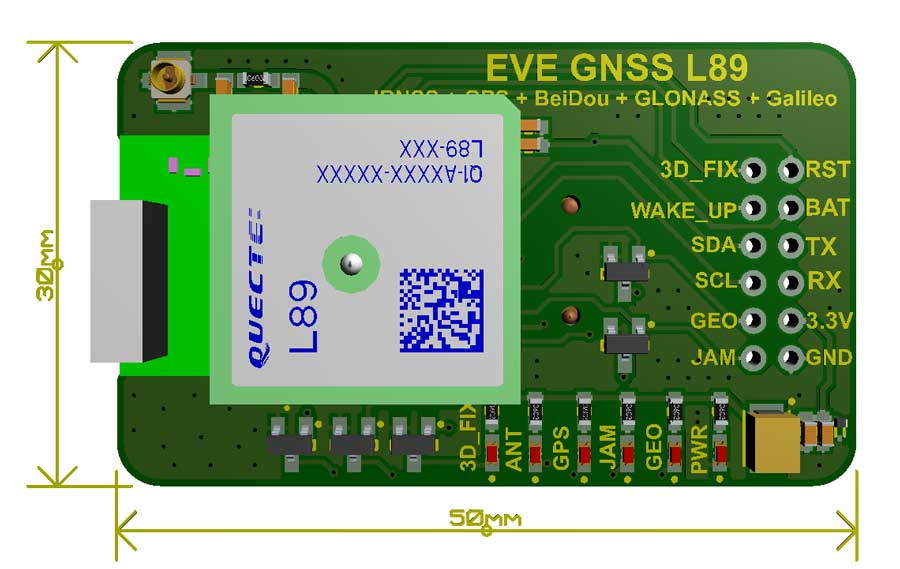
L89 Breakout Arduino Connection

Arduino Code for GPS Read
#include <SoftwareSerial.h> // Include the SoftwareSerial library
#define ARDUINO_GPS_RX 9 // Arduino RX pin connected to GPS TX
#define ARDUINO_GPS_TX 8 // Arduino TX pin connected to GPS RX
#define GPS_BAUD_RATE 9600 // The GPS Shield module defaults to 9600 baud
// Create a SoftwareSerial object called gps:
SoftwareSerial gpsPort(ARDUINO_GPS_TX, ARDUINO_GPS_RX);
// This is the hardware serial port on pins 0/1.
#define SerialMonitor Serial
void setup()
{
gpsPort.begin(GPS_BAUD_RATE);
SerialMonitor.begin(9600);
}
void loop()
{
if (gpsPort.available()) // If GPS data is available
SerialMonitor.write(gpsPort.read()); // Read it and print to SerialMonitor
if (SerialMonitor.available()) // If SerialMonitor data is available
gpsPort.write(SerialMonitor.read()); // Read it and send to GPS
}
L89 Breakout Vs L86 Breakout
| Parameters | L89 Breakout | L86 Breakout |
| Image | 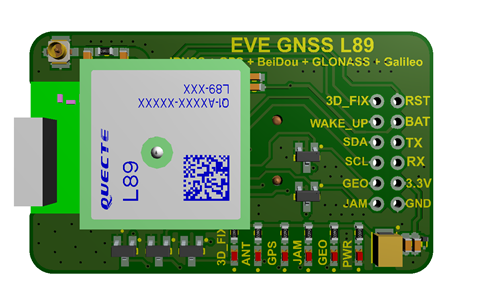 |
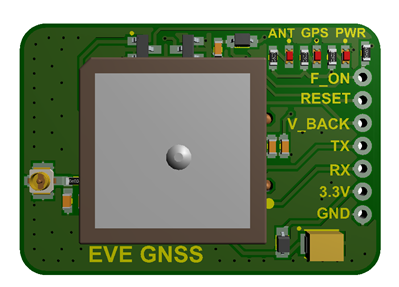 |
| Receiving Bands | GPS L1/Galileo E1 C/A: 1575.42 MHz | GPS L1 Band Receiver (1575.42MHz) |
| GLONASS L1 C/A: 1602.5625 MHz | GLONASS L1 Band Receiver (1601.71MHz): | |
| IRNSS L5 C/A: 1176.45 MHz | ||
| BD2 B1 C/A: 1561.098 MHz | ||
| SBAS | WAAS, EGNOS, MSAS, GAGAN | WAAS, EGNOS, MSAS, GAGAN |
| Horizontal Position Accuracy | Autonomous: < 1.8 m CEP | Autonomous: <2.5m CEP |
| Velocity Accuracy | Without Aid: < 0.1 m/s | Without Aid: <0.1m/s |
| Acceleration Accuracy | Without Aid: < 0.1 m/s² | |
| Timing Accuracy | 1PPS: 3.9 ns | 1PPS Out: 10ns |
| Reacquisition Time | < 1.5 s | <1s |
| Sensitivity | Acquisition: -147 dBm Tracking: -163 dBm Reacquisition: -156 dBm |
Acquisition: -149dBm Tracking: -167dBm Reacquisition: -161dBm |
| Dynamic Performance | Maximum Altitude: Max. 18000 m Maximum Velocity: Max. 515 m/s Maximum Acceleration: 4G |
Maximum Altitude: Max. 18000m Maximum Velocity: Max. 515m/s Maximum Acceleration: 4G |
| Link | L89 Breakout | L86 Breakout |





